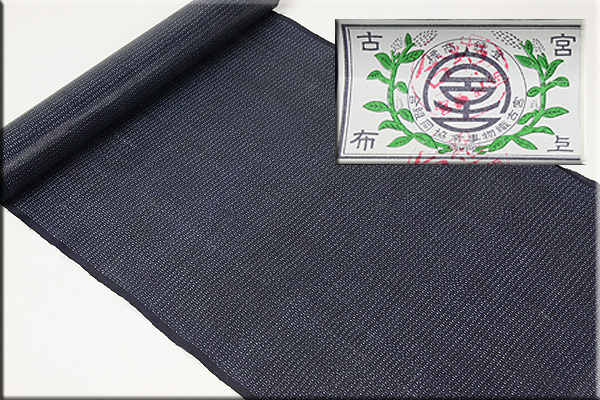( image from : http://kimono-hiroba.jp/image/okinawaten/miyako.html )
Miyako Jofu in general
Miyako Island(宮古島) is located 326km south-west of main island Okinawa. 40 thousand people resides there nowadays.
The “Miyako jofu(宮古上布)” implies high-quality plain-woven hemp cloth that have been developed throughout the history of Miyako Island. Contemporaly, “Miyako Jofu” becomes one of the qualified traditional hemp clothes in Japanese archipelago.
There are regional differences among the Okinawan traditional hemp cloths. Compared to the Yaeyama Jofu(about 75km south-west of Miyako Island, 八重山上布)which dyed with red rusted color, “Miyako Jofus” are dyed with indigo and are more dark blue color.
It is woven by ramie (芋麻). The comfort and coolness of “Miyako Jofu” made by ramie were highly valued in the summer time. It has once said that people would never desire to have other outfits once you dressed with “Miyako jofu”.
The origin of the “Miyako Jofu” was believed to be around 16th century when Ryukyu kingdom had tributary system with Chinese Min Dynasty. One of the Islander, Shimoji (下地) shipwrecked before he reached to the annual greeting to the King of Ryukyu. After lost at the sea, he eventually arrived at coast of China. Fortunately, he found the tributary ships to go home with. On the way back to Okinawa, the ship encountered devastating hurricanes, and without Shimoji’s nimble work, the ship would have wrecked again. All the passengers of tributaries made their home. The King was surprised to hear that news, and happily gave him entitled position in the Kingdom. After this incidents, his wife, Inaishi (稲石) wanted to show appreciation to the King in return. Inaishiin waved clothes with most delicate manner. It was beautiful blown color with stripe. The king was fully surprised again when he wore it. This Jofu was believed to be the origin of “Miyako Jofu”.
Under the strict feudal controls
As scholar discussed, the development of “Miyako Jofu(宮古上布)” would have other destiny if feudal controls of Satsuma, one of the strong feudal domain of Tokugawa Bakufu did not happened in the past.
After main islands of Okinawa invaded by Satusma, the Miyako Islanders also went under their influences. As other Okinawan people, Miyako Islander also experienced two governmental controls.
Especially, the poll taxes to Miyako Islanders are crucial at that time. Because of its high quality, Satsuma requested “Miyako jofu” as to pay. The record shows that out of 3367 koku (app 60,000kg, 1 koku石=app 180L), the 2216 Koku were from cloth fabric including the “Miyako Jofu” Because of this unreasonable demand, all females under 15 to 50 had to joins yarn-making (製糸), dyeing (染色), and weaving (製織) in the villages.
The dedication of the taxes took place on March each year. After the strict inspection by Satsuma’s bureaucrat, only the ones that reached to the quality that Satsuma requested were accepted. People broke down crying at the moment of the judge. The textile dedicated to the high nobles, the skilled islanders were chosen by villagers and forced to wave every day from morning until night.
Among the Okinawans, the colorful outfits are more favored. In contrast, Satsuma requested darker color, indigo dyed “Miyako jofu” because Satsuma exports to the main land where indigo is more favored.
Thus, most elegant textiles in Okinawan Island has undergone these sorrowful histories. Even though the end of Edo Bakufu era and new modernized Meiji government took place, this poll tax had lasted for 36 years after.
Miyako Jofu as a Textile
1). Ramie Fabric(原材料, 芋麻)
The basic material, yarn for “Miyako jofu” is ramie, one of the hemp. Ramies plants are cultivated throughout the Miyako Island. They are collected 4-5 times a year. Within 30-40 days they grow. When they become 1.5m in height, they are cut down. After collection from the field, they are washed with abalones shells. With abalone shells, fibers can be smoothly collected. After collection of fibers of ramie, they are dried in the shade.
2). Spinning(糸績み)
Dried fibers are torn with nails and fingers until they get to the thickness of hairs. Spining ramie fibers into thread are all done by hand. Warps(経糸) are made of 2 yarns. Wefts(横糸)are made of one yarn. Spun yeans are twisted by spinning wheels. After wefts are made, warping of warps are done (warping is the process that winding the warps by required length, density, and order).
3). Design and Kasurijime(図案と絣締め)
The basic design are drawn down to the graphic paper. The first, the whole design of “Miyako jofu” is decided. Since the whole design is made of small patterns or partial design. The small “Miyako jofu” made up of 6 repetition of a part as well as 121 in the largest ones.
After designs are decided, the warped yarns are washed by bleach. After bleaching and drying, the warped yarns are tightly woven. The method is called Kasurishime(絣締め). The purpose is to protect portion of yarns. To do so, the portion of yarns would not be dyed in the next process.
4). Dyeing(染色)
The Dyeing by Indigo. The basic material is Ryukyu indigo. The caustic soda, awamori (Okinawan distilled sprit), brown sugars are added. Ferment for a week or two. After fermentation, the color of dye become greenish. Dyed and dried under sunshine for a day. Repeated dyeing 15-16 times.
5). Weaving(製織)
After dyeing and drying, the yarns are woven crosswise. Ship shaped shuttle(杼) is used to weave warps(経糸)and Wefts(横糸). Even skilled worker can weave 20-30 cm a day. The whole roll can be made in about 3-4 months.
6). Washing and inspection (洗濯加工と検査)
Washed off the dirt in the hot boiled water. After dried, strengthen the fabric by wooden hammer 20,000-25,000 times. After inspection, the roll of “Miyako jofu”, one of the four traditional high quality hemp clothes in Japan archipelago would be in the markets.
References
田中俊雄、田中玲子(1976)『沖縄織物の研究』。紫紅社。
宮古島市教育委員会、地域伝統文化伝承事業編『宮古上布-その手芸-』宮古上布保持団体。
宮古織物事業協同組合、作業工程(http://miyako-joufu.com/)
